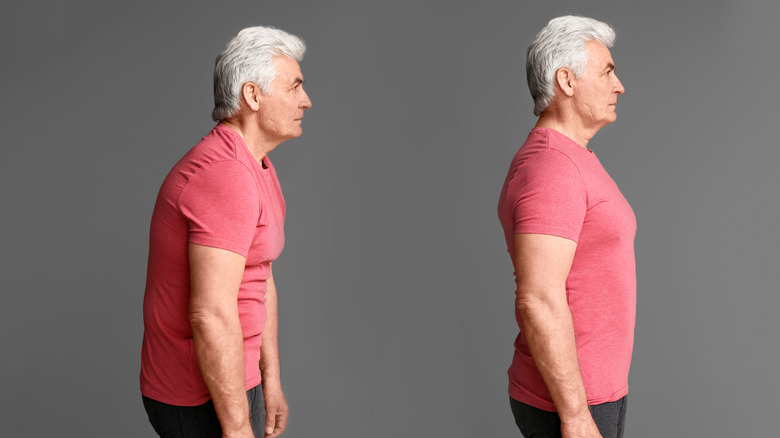What Does It Mean When You Have A Dowager's Hump?
There are some wonderful reasons to look forward to the aging process. The gained wisdom, a better sense of self, and hopefully some fabulous memories to think fondly over. Aging has so many positive aspects but oftentimes, many of us are too distracted by the physical changes that happen over time to really enjoy our ripest years. The physical sign currently in the spotlight is particularly visible, though the mainstream has yet to make the name popular. We're talking about the noticeable stooped-over posture a lot of elders are strutting around with.
The non-medical name for this physical trait that describes the bending forward of the spine is the "dowager's hump." More frequently found in women, this conditions occurs when the upper back curves, causing shrinking in the front parts of the vertebrae. This causes the individual to naturally start slouching forward, both with their back and shoulders, thus creating the look of a hump on the upper back (via Griswold Home Care).
The dowager's hump, which medical professionals call kyphosis, doesn't happen overnight. Spine expert Fredrick Wilson, DO, explained that this condition usually starts to develop around middle age. "It generally takes a while to develop because it's a long-term weakening of the thoracic extensor muscles," he told Cleveland Clinic.
You can improve or reverse a Dowager's Hump
So why do some seniors eventually form the dowager's hump? There are a few known explanations. The first is that kyphosis can be a side effect of intense osteoporosis, notes Griswold Home Care. Cushing's syndrome, a condition that causes the body to overproduced cortisol, can also lead to an upper back hump. In some instances, a dowager's hump can be a side effect of certain medications, such as those taken to treat AIDS.
If you start to notice yourself stooping and a hump forming on your upper back, there are ways to improve or reverse the dowager's hump. Spine expert Frederick Wilson recommends a series of stretches and exercises for the back such as push-ups and scapular squeezes to help correct your posture. "Luckily, they don't take a lot of time. And if you do them regularly, you are going to have less pain, more energy and you'll feel all around better," he told Cleveland Clinic.
If strutting with a dowager's hump is not in the plans for your riper years, then keep your posture a priority now and for the years to come — no slouching! And remember to make an appointment with your physician if you have any spinal concerns or upper back pain.

